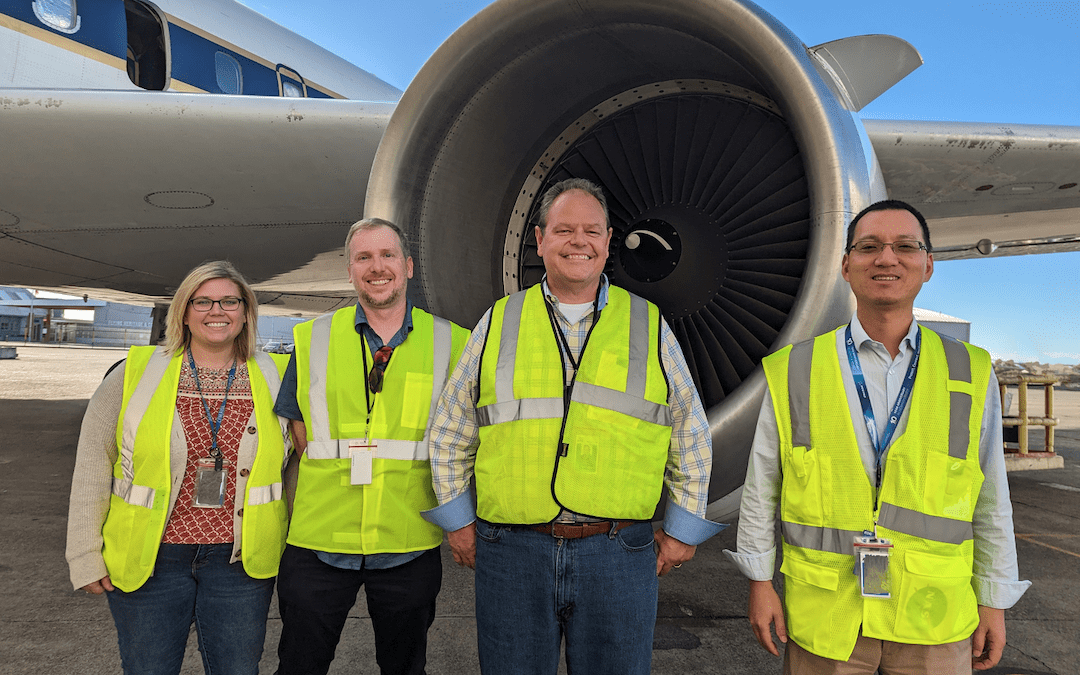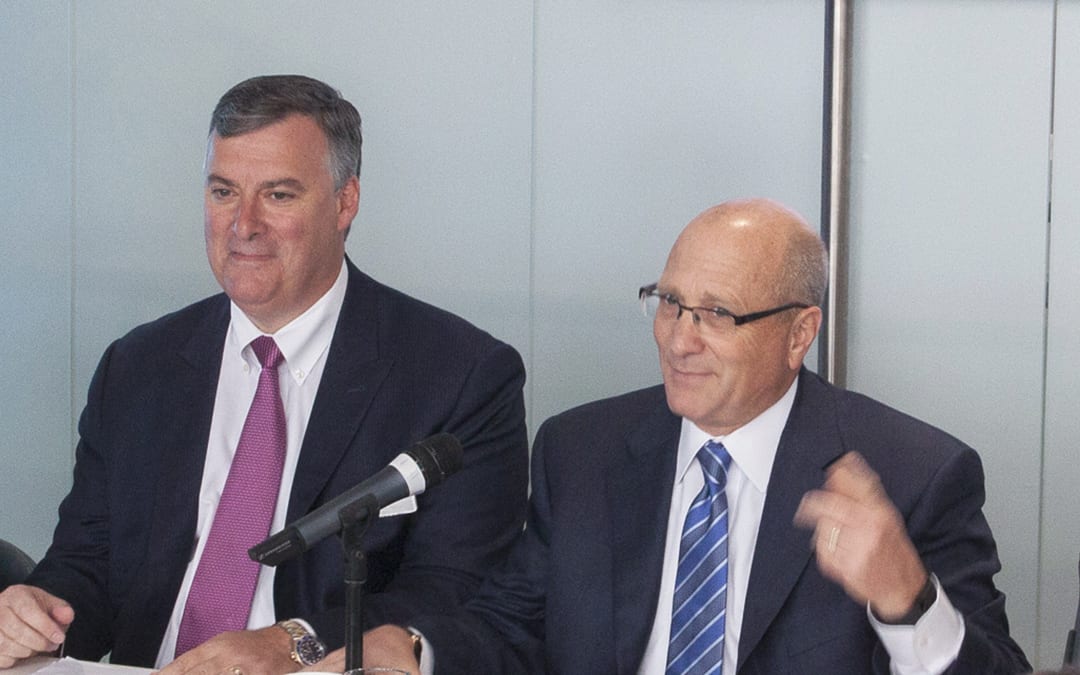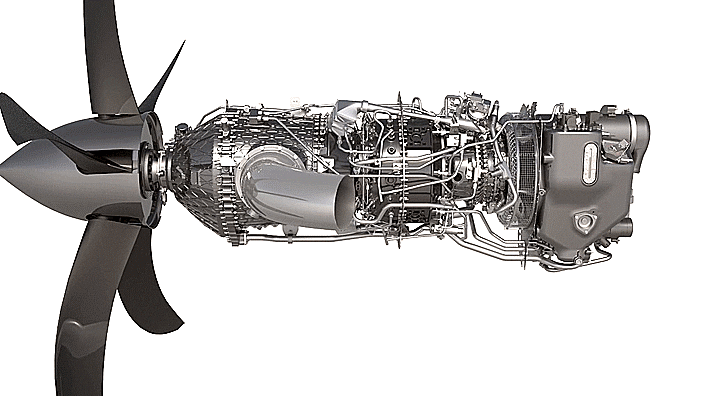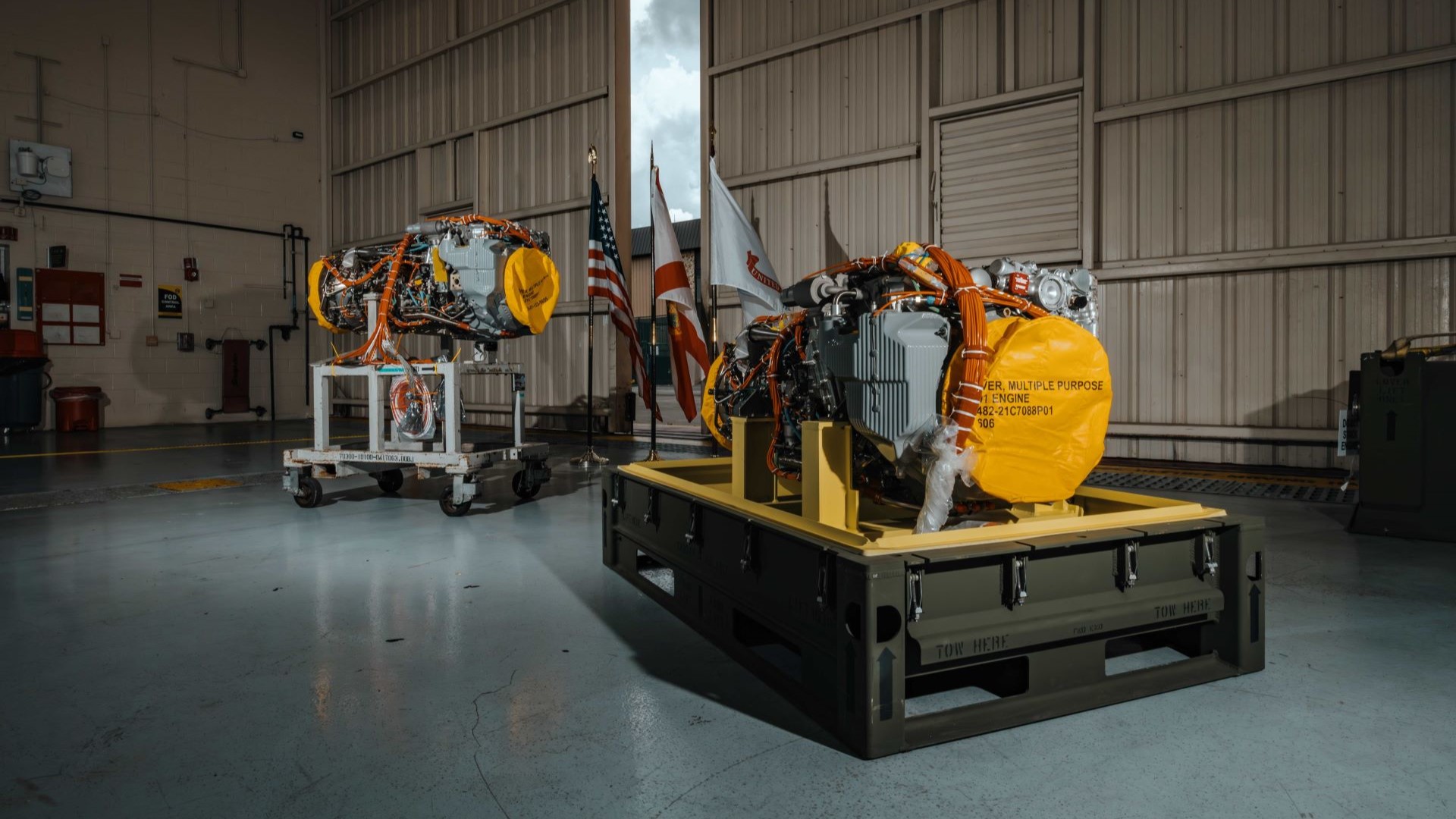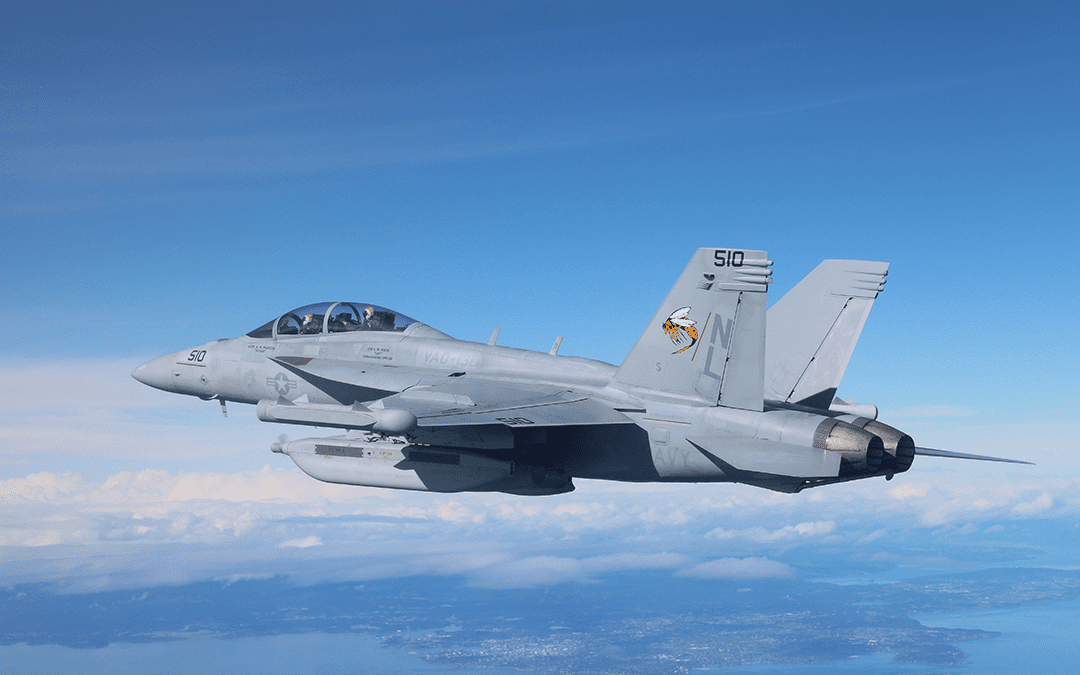Chasing the Contrails: GE Aerospace Teams Up with NASA and Boeing to Take a Closer Look at Emissions
November 7, 2023 | by GE Reports
The scene about 36,000 feet in the air somewhere north of Seattle has shades of a techno-thriller: Two jets are loaded with an international team of experts from GE Aerospace, NASA, Boeing, German Aerospace Center (DLR), and elsewhere. A NASA DC-8, bristling with probes and sensors, pursues Boeing’s ecoDemonstrator Explorer, a 737-10 destined for United Airlines whose CFM LEAP-1B engines are operating with HEFA sustainable aviation fuel (SAF). The DC-8 is dogging the 737-10’s trail like a submarine pursuing a sonar signature, seeking data that could help turn the tide against climate change.
For a team of GE Aerospace engineers supporting the tests, the chase itself is a kind of victory.
“The most exciting thing for me is being able to monitor an engine that I’ve spent 10 years with,” says combustor design principal engineer Hejie Li, who earned a Stanford PhD in combustion before joining GE Aerospace to work on designing the CFM LEAP engine. (CFM International is a 50-50 joint company between GE Aerospace and Safran Aircraft Engines.) “I have a real emotional attachment to the LEAP engine.”
Sitting in the cabin of the ecoDemonstrator, Li monitors temperature and fuel flow to ensure that the engines are operating within representative parameters. The data he gathers is crucial to developing more efficient, lower-emission commercial combustion engines.
In the air and on the ground, Li is supported by David Ostdiek, the CFM RISE systems team’s aerothermal leader, and Cassi Miller, a RISE systems leader focused on climate impacts, both of whom typically ride in the DC-8; Edwina Sharp, flight test engineering manager, who rode in the 737-10; and by combustion systems leader Ryan Jones, who monitors the flights almost as closely from his post at GE Aerospace’s headquarters in Evendale, Ohio. All five are in constant communication with the Boeing and NASA teams, ensuring that the tests run smoothly, that the airplanes’ interactions are well understood, and that high-quality data flows to an international climate science team.
This data will help illuminate a vast and potentially transformative range of unknown factors in airplane emissions. “As we’re inventing the next generation of engines with the RISE program, we really want to understand the science around non-CO2 emissions,” says Ostdiek. First unveiled in 2021, the CFM RISE program is a comprehensive suite of engine technologies being matured for ground and flight tests this decade including new architectures like open fan, as well as compact core advancements including the combustor. The RISE program aims to achieve 20% better fuel efficiency and 20% fewer CO2 emissions than engines today, while also reducing noise and non-CO2 emissions.
“Our team is responsible for integration of the POC disciplines: performance, operability, controls,” he adds. “That means understanding how the engine operates and why it operates as it does, and modeling the overall system. The more data we get on climate effects, the better we’ll be able to make minimizing them a new key requirement.”
Yet contrails remain full of uncertainty. Miller, who modeled contrail formations in grad school, is focused on measuring their impact. As complex as the study of cloud formation and movement already is, it’s only compounded by an interaction with technology. “We need to understand these unique interactions that happen at high as well as low altitudes, and how they affect climate,” Miller says.
Though based in Lynn, Massachusetts, Miller is spending the better part of October somewhere above the Seattle area, connecting and collaborating with the NASA teams, science teams, and researchers during each four- to six-hour flight, some of which involve the thrill of an actual chase. “The DC-8 pilots have to find the 737-10’s exhaust, and sometimes we want to sample it really close, within a mile,” she says. “And sometimes we want to sample it from really far away, like 20 miles back. Sometimes the contrails form and they look like a highway you’re flying into. Sometimes they don’t form and the pilots have to fly in and out and at different altitudes to pick up and lock onto the trail.”
Inside, Miller and Ostdiek watch video screens fed by one of the DC-8’s forward-facing cameras. Each group of scientists monitors a particular instrument, their probes sticking out of the aircraft’s windows and sides and the underside of the fuselage. “If you can’t see the contrail, then you follow weather predictions, wind measurements, known altitude of the lead aircraft, and its flight path,” says Miller. “And you look at the science instruments for, say, a spike in particulate matter, which lets you know you’ve found the plume. Then you’ll hear a scientist yell, ‘Hey, we have a hit!’ and the pilots hold that course.”
Back in Evendale, Ryan Jones works with the combustion team on new technology development while keeping a close eye on the data the tests are generating for future combustion modeling.
“This test is really significant, partially because it’s a partnership with NASA, Boeing, and all these other people,” says Jones. “They’re giving us crucial feedback to help guide the industry to a decision point in the next generation of aviation. So that when we discuss new engines for a particular customer, we know which architecture fits their priorities.”
“We keep asking ourselves, ‘What’s the absolute best minimal-impact engine you can have?’” Jones says. “Let’s go figure that out. Because we’ve got decades of experience at GE Aerospace with combustion systems, we can tailor a combustion system to do almost anything. But we need to know what the science is so we can go and make it.”
Which is where the ecoDemonstrator comes in. Gleaning masses of data across many parameters on each test flight, the team follows correlations — between fuel types, combustion architecture, and more — that will allow them to reduce emissions by pulling the levers they have — such as SAF and lean-burn combustion — and finding new ones to pull in the future.
“We know that if you combine a very high-quality fuel with a really high-quality combustion process, the particulate emissions are reduced,” says Ostdiek. “But beyond this there are so many unknowns. What are the secondary interactions: trace particles from combustion inefficiencies that aren’t soot but unburned hydrocarbons, say, or the tiny amount of oil we put out, or sulfur? These tests, and all these instruments, are working to improve our modeling, and help us better understand the bigger picture.”
“When we think of the term RISE — Revolutionary Innovation for Sustainable Engines — what we’re doing is trying to get to the heart of what sustainability actually is,” says Miller. “When the RISE program kicked off, we were really focused on minimizing CO2 and fuel burn. But now that the science is starting to tell us that there are other pieces that contribute to climate impact, we’re putting those in as well, to make sure that we’re really making a more sustainable engine at the end of this technology program.”
While it’s way too soon for a victory lap, their process of discovery has no shortage of excitement. Having spent years designing on computers and running tests at Evendale, Li is finding the actual flights a whole different story. “Sitting just a few yards from the engine and looking to see how it’s performing, to some extent it’s a career-defining moment,” he says. “When people ask you, ‘What’s the best part of having a job at GE Aerospace?’ I’d say this is it: running tests on the engine you designed on the actual aircraft. I have to say, there’s nothing like it.”
For a team of GE Aerospace engineers supporting the tests, the chase itself is a kind of victory.
“The most exciting thing for me is being able to monitor an engine that I’ve spent 10 years with,” says combustor design principal engineer Hejie Li, who earned a Stanford PhD in combustion before joining GE Aerospace to work on designing the CFM LEAP engine. (CFM International is a 50-50 joint company between GE Aerospace and Safran Aircraft Engines.) “I have a real emotional attachment to the LEAP engine.”
Sitting in the cabin of the ecoDemonstrator, Li monitors temperature and fuel flow to ensure that the engines are operating within representative parameters. The data he gathers is crucial to developing more efficient, lower-emission commercial combustion engines.
In the air and on the ground, Li is supported by David Ostdiek, the CFM RISE systems team’s aerothermal leader, and Cassi Miller, a RISE systems leader focused on climate impacts, both of whom typically ride in the DC-8; Edwina Sharp, flight test engineering manager, who rode in the 737-10; and by combustion systems leader Ryan Jones, who monitors the flights almost as closely from his post at GE Aerospace’s headquarters in Evendale, Ohio. All five are in constant communication with the Boeing and NASA teams, ensuring that the tests run smoothly, that the airplanes’ interactions are well understood, and that high-quality data flows to an international climate science team.
This data will help illuminate a vast and potentially transformative range of unknown factors in airplane emissions. “As we’re inventing the next generation of engines with the RISE program, we really want to understand the science around non-CO2 emissions,” says Ostdiek. First unveiled in 2021, the CFM RISE program is a comprehensive suite of engine technologies being matured for ground and flight tests this decade including new architectures like open fan, as well as compact core advancements including the combustor. The RISE program aims to achieve 20% better fuel efficiency and 20% fewer CO2 emissions than engines today, while also reducing noise and non-CO2 emissions.
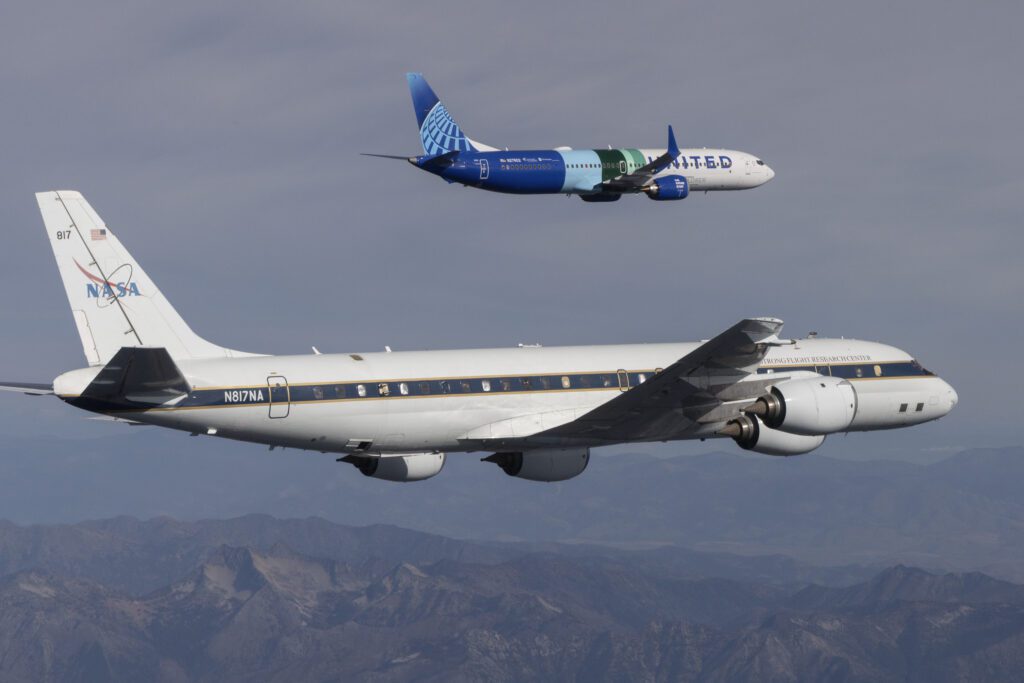 This NASA DC-8 is tailing Boeing’s ecoDemonstrator Explorer, a 737-10 destined for United Airlines that is operating on sustainable aviation fuel, to take readings on its exhaust and help learn more about how SAF impacts contrail formation and other environmental effects. Credit: Andy Wolfe, Top: The GE Aerospace team supporting the EcoDemonstrator project, from left: Cassi Miller, CFM RISE program senior staff engineer; David Ostdiek, CFM RISE systems aerothermal leader; John Wojno, GE Aerospace external programs manager; and Hejie Li, GE Aerospace combustor design principal engineer.
This NASA DC-8 is tailing Boeing’s ecoDemonstrator Explorer, a 737-10 destined for United Airlines that is operating on sustainable aviation fuel, to take readings on its exhaust and help learn more about how SAF impacts contrail formation and other environmental effects. Credit: Andy Wolfe, Top: The GE Aerospace team supporting the EcoDemonstrator project, from left: Cassi Miller, CFM RISE program senior staff engineer; David Ostdiek, CFM RISE systems aerothermal leader; John Wojno, GE Aerospace external programs manager; and Hejie Li, GE Aerospace combustor design principal engineer.
“Our team is responsible for integration of the POC disciplines: performance, operability, controls,” he adds. “That means understanding how the engine operates and why it operates as it does, and modeling the overall system. The more data we get on climate effects, the better we’ll be able to make minimizing them a new key requirement.”
Yet contrails remain full of uncertainty. Miller, who modeled contrail formations in grad school, is focused on measuring their impact. As complex as the study of cloud formation and movement already is, it’s only compounded by an interaction with technology. “We need to understand these unique interactions that happen at high as well as low altitudes, and how they affect climate,” Miller says.
Though based in Lynn, Massachusetts, Miller is spending the better part of October somewhere above the Seattle area, connecting and collaborating with the NASA teams, science teams, and researchers during each four- to six-hour flight, some of which involve the thrill of an actual chase. “The DC-8 pilots have to find the 737-10’s exhaust, and sometimes we want to sample it really close, within a mile,” she says. “And sometimes we want to sample it from really far away, like 20 miles back. Sometimes the contrails form and they look like a highway you’re flying into. Sometimes they don’t form and the pilots have to fly in and out and at different altitudes to pick up and lock onto the trail.”
Inside, Miller and Ostdiek watch video screens fed by one of the DC-8’s forward-facing cameras. Each group of scientists monitors a particular instrument, their probes sticking out of the aircraft’s windows and sides and the underside of the fuselage. “If you can’t see the contrail, then you follow weather predictions, wind measurements, known altitude of the lead aircraft, and its flight path,” says Miller. “And you look at the science instruments for, say, a spike in particulate matter, which lets you know you’ve found the plume. Then you’ll hear a scientist yell, ‘Hey, we have a hit!’ and the pilots hold that course.”
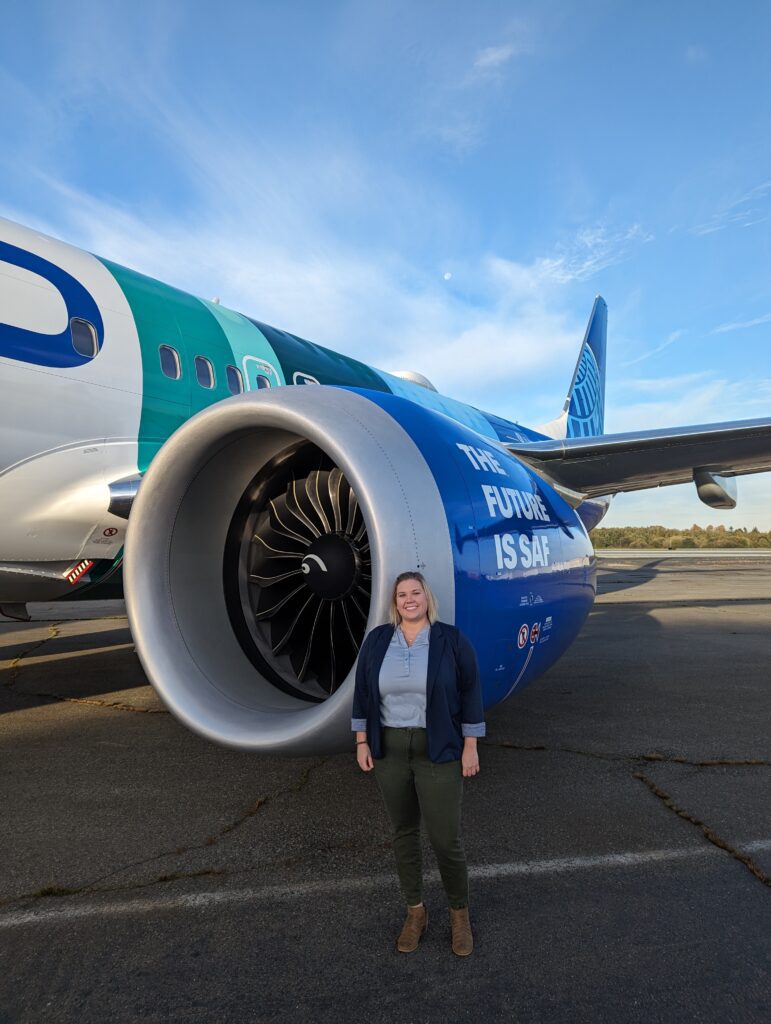 "What we’re doing is trying to get to the heart of what sustainability actually is," says CFM RISE program senior staff engineer Cassi Miller.
"What we’re doing is trying to get to the heart of what sustainability actually is," says CFM RISE program senior staff engineer Cassi Miller.
Back in Evendale, Ryan Jones works with the combustion team on new technology development while keeping a close eye on the data the tests are generating for future combustion modeling.
“This test is really significant, partially because it’s a partnership with NASA, Boeing, and all these other people,” says Jones. “They’re giving us crucial feedback to help guide the industry to a decision point in the next generation of aviation. So that when we discuss new engines for a particular customer, we know which architecture fits their priorities.”
“We keep asking ourselves, ‘What’s the absolute best minimal-impact engine you can have?’” Jones says. “Let’s go figure that out. Because we’ve got decades of experience at GE Aerospace with combustion systems, we can tailor a combustion system to do almost anything. But we need to know what the science is so we can go and make it.”
Which is where the ecoDemonstrator comes in. Gleaning masses of data across many parameters on each test flight, the team follows correlations — between fuel types, combustion architecture, and more — that will allow them to reduce emissions by pulling the levers they have — such as SAF and lean-burn combustion — and finding new ones to pull in the future.
“We know that if you combine a very high-quality fuel with a really high-quality combustion process, the particulate emissions are reduced,” says Ostdiek. “But beyond this there are so many unknowns. What are the secondary interactions: trace particles from combustion inefficiencies that aren’t soot but unburned hydrocarbons, say, or the tiny amount of oil we put out, or sulfur? These tests, and all these instruments, are working to improve our modeling, and help us better understand the bigger picture.”
“When we think of the term RISE — Revolutionary Innovation for Sustainable Engines — what we’re doing is trying to get to the heart of what sustainability actually is,” says Miller. “When the RISE program kicked off, we were really focused on minimizing CO2 and fuel burn. But now that the science is starting to tell us that there are other pieces that contribute to climate impact, we’re putting those in as well, to make sure that we’re really making a more sustainable engine at the end of this technology program.”
While it’s way too soon for a victory lap, their process of discovery has no shortage of excitement. Having spent years designing on computers and running tests at Evendale, Li is finding the actual flights a whole different story. “Sitting just a few yards from the engine and looking to see how it’s performing, to some extent it’s a career-defining moment,” he says. “When people ask you, ‘What’s the best part of having a job at GE Aerospace?’ I’d say this is it: running tests on the engine you designed on the actual aircraft. I have to say, there’s nothing like it.”
